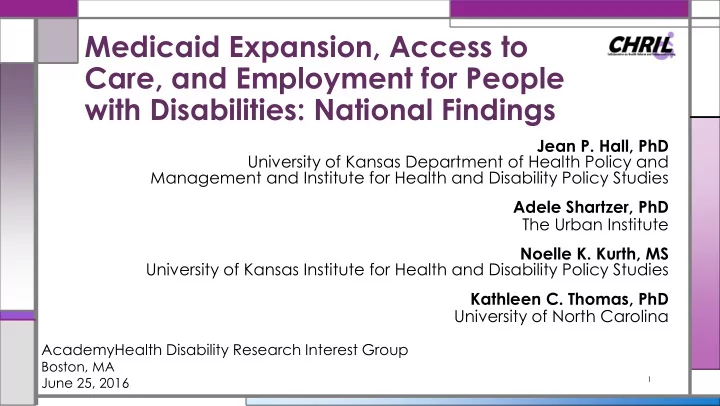

Medicaid Expansion, Access to Care, and Employment for People with Disabilities: National Findings Jean P. Hall, PhD University of Kansas Department of Health Policy and Management and Institute for Health and Disability Policy Studies Adele Shartzer, PhD The Urban Institute Noelle K. Kurth, MS University of Kansas Institute for Health and Disability Policy Studies Kathleen C. Thomas, PhD University of North Carolina AcademyHealth Disability Research Interest Group Boston, MA June 25, 2016 1
Background Little is known about specific experiences of people with disabilities after ACA coverage expansions Marketplace coverage cannot exclude people with pre-existing conditions Medicaid expansion has the potential to support employment because the earnings threshold may be higher and assets are not capped Perhaps end the cycle of Health Insurance Motivated Disability Enrollments 2
Research Objectives Examine insurance coverage, access to care, and employment among adults with disabilities pre- and post-ACA coverage expansions Document differences between states with and without Medicaid expansion Combine with other findings from the larger CHRIL project to more fully understand the impact of the ACA on people with disabilities 3
Methods Data from the Urban Institute's Health Reform Monitoring Survey (HRMS) Nationally-representative internet panel survey of adults fielded periodically since 2013* Over-samples people with chronic conditions and allows comparisons between Medicaid expansion and non- expansion states 2,740 adult respondents with a disability (ages 18-64 years) Do you have a physical or mental condition, impairment, or disability that affects your daily activities OR that requires you to use special equipment or devices, such as a wheelchair, TDD, or communications device? *The HRMS was fielded quarterly from Q1 2013-Q1 2015, after which the survey shifted to a biannual fielding schedule. These analyses uses data from ten rounds of the HRMS, Q1 2013-Q3 2015. 4
Demographics Medicaid Non-Expansion All Adults with Expansion states a states a a disability Characteristics (n=1,639) (n=1,101) (n=2,740) P Value Age in years (%) 18-24 11.6 8.1 10.0 .03 25-34 17.5 15.9 16.8 35-44 16.4 15.1 15.8 45-54 24.1 26.1 25.0 55-64 30.4 34.8 32.4 Race/Ethnicity (%) White, non-Hispanic 67.2 67.3 67.3 Black, non-Hispanic 12.3 17.6 14.7 Other/multi., non-Hispanic 6.5 5.3 5.9 Hispanic 14.0 9.8 12.1 Education (%) Less than high school 18.9 17.4 18.2 High school graduate 59.6 67.5 63.2 .008 College graduate 21.5 15.1 18.6 .008 a Medicaid expansion status as of December 2014, includes AZ, AR, CA, CO, CT, DE, 5 DC, HI, IL, IA, KY, MD, MA, MN, NV, NJ, NM, ND, NY, OH, OR, RI, VT, WA, WV, MI, and NH
Analyses Multivariate regression models with recycled predictions compared trends between Q1-Q3 2013 (pre-ACA) to Q4 2014-Q3 2015 (post-ACA) using pooled cross-sectional estimates Looked at insurance coverage status, access to care, and employment overall and by state Medicaid expansion status for 2,740 adult respondents Models controlled for age, gender, race/ethnicity, primary language, education level, marital status, household income, self-reported health status, US region, metropolitan status and local-area employment rates 6
Overall Findings Significantly greater percentages of people with disabilities reported having a usual source of care post-ACA (84.5 % versus 74%, p<.001) Post-ACA, respondents in Medicaid expansion states were significantly less likely to report having been uninsured for the year (-2.6%, p<0.001) and more likely to be employed (6.1%, p<0.001) compared to those in non-expansion states. 7
Adjusted Outcomes: Post-ACA Differences Adults with a Adults with a disability disability in in Medicaid non- Expansion Expansion states a states 1 (n=1,639) (n=1,101) P Value Employment Status (%) Working as paid employee 38.0 31.9 p<.001 or self-employed Not working, excluding due 22.3 19.7 p<.001 to disability Not working, disabled 39.7 48.4 p<.001 3.0 5.6 p<.001 Uninsured for full year (%) a Medicaid expansion status as of December 2014, includes AZ, AR, CA, CO, CT, DE, DC, HI, 8 IL, IA, KY, MD, MA, MN, NV, NJ, NM, ND, NY, OH, OR, RI, VT, WA, WV, MI, and NH
Conclusions Reports of being uninsured were significantly lower in Medicaid expansion states, reinforcing the importance of expansion coverage to people with disabilities Prior to the ACA, many people with disabilities were locked into poverty to maintain eligibility for Medicaid. With Medicaid expansion, they can now work, accumulate assets, and maintain coverage. Medicaid expansion may serve the dual purpose of being a work incentive and insurance program for this population that has historically been discouraged from employment. More people with disabilities in all states reported improved access to care post-ACA, potentially decreasing long-standing health disparities for this group. 9
Study Limitations and Next Steps Data are self-reported; some may not report a disability (e.g., disclosure not needed for benefits) A small number of states implemented early Medicaid expansions during 2013, which may have led to an underestimation of expansion effects Early work seems to indicate differential effects for people with psychiatric disabilities, who may be less likely to work even in Medicaid expansion states; will look at other differences for this population as well 10
Contact Information Jean P. Hall, PhD Phone: (785) 864-7083 Email: jhall@ku.edu Website: www.chril.org The HRMS instrument is available online at http://hrms.urban.org/survey-instrument The contents of this presentation were developed under the Collaborative for Health Reform and Independent Living (CHRIL), a grant from the National Institute on Disability, Independent Living, and Rehabilitation Research (NIDILRR, grant number 90DP0075-01-00). NIDILRR is a Center within the Administration for Community Living (ACL), Department of Health and Human Services (HHS). Funding for the HRMS comes from the Robert Wood Johnson Foundation (RWJF, contract #72731). The contents of this presentation do not necessarily represent the policy of NIDILRR, ACL, HHS, or RWJF and you should not assume endorsement by the Federal Government. 11
Recommend
More recommend